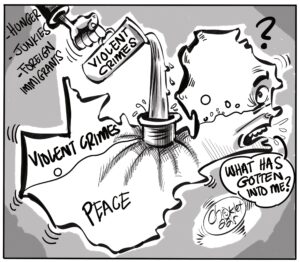Birth registration coverage for Zambians currently stands at only 11.2 per cent, according to the Ministry of Home Affairs.
Ministry of Home Affairs Permanent Secretary Pamela Kabamba revealed this during a media workshop on civil registration in Chisamba yesterday where she also cited the UN Economic Commission for Africa in disclosing that millions of children under the age of five in Africa were not protected with legal documents.
Kabanda said this in a speech read on her behalf by Department of National Registration, Passport and Citizenship Registrar-General Mathews Nyirongo.
“According to a statement issued by the United Nations Economic Commission for Africa on 21 May, 2013, only 44 per cent of children under the age of five in Africa are registered and millions more are not protected with legal identity documents. Sadly, Zambia is at 11.2% birth registration coverage, according to the 2013/2014 Zambia Demographic Health Survey, which is among the lowest in Africa. To address the challenges of lack of awareness on the importance of civil registration, generally, and birth registration specifically, my Ministry will soon launch an advocacy and communication strategy, which will act as a guiding tool for all actors. This strategy will, among other things, be used to guide creation and knowledge-sharing about civil registration at community level; advocate for policy alignment to ensure that provisions on births registration are aligned with policies directly impacting children such as health and education, and guide strategic engagement of key participants involved in changing the way that births registration is perceived,” Kabamba said.
She said Zambia’s 11.2 per cent birth registration coverage was due to lack of awareness by locals on its importance, among other factors.
“My Ministry is alive to the following factors that are behind the low coverage in birth registration; lack of awareness on the importance of birth registration; the long distance to registration centres by many people in far flung areas; and centralized certification, which is being addressed through the implementing of Statutory Instrument Number 44 of 2016. My Ministry is working with the Ministry of Health to address the challenge of long distances that our people have to cover to access registration services. Starting from 2012, my Ministry has established close to 500 registration centres in health facilities, in collaboration with the Ministry of Health, and with support from UNICEF. This approach has made birth registration easier,” Kabamba added.
And UNICEF Zambia Chief of Child Protection Katlin Brasic observed that Zambia’s low civil registration was due to centralized supply and low demand by communities, among others.
“In 2012, UNICEF supported the DNRPC to undertake an analysis on birth registration in Zambia to learn more about the bottlenecks and barriers for people registering children. In 2013/14 UNICEF also supported the NDRPC to conduct a comprehensive review of the National Civil Registration and Vital Statistics system because we realised that birth registration does not exist in isolation, but is part of the bigger civil registration system. Findings from both the bottleneck analysis and the comprehensive assessment exercises showed similar trends. They revealed that Zambia has low civil registration mainly because of three main reasons. Firstly, what we call the enabling environment; secondly, the centralised supply or service delivery system; and thirdly, low demand by communities. From these findings, we made a deliberate decision to prioritize our interventions by firstly focussing our support to the government in strengthening the enabling environment and service delivery systems before embarking on demand creation among communities. The decision is already beginning to bear fruits,” Brasic said.
She said the existence of alternative documents like under-5 cards and affidavit forms being accepted in place of birth certificates has contributed to low demand for birth registration.
“Whilst the legal provisions for birth registration have been relatively strong, enforcement has not. The result has been the existence of alternative documents like under-5 cards and affidavit forms being accepted in place of a birth certificate in accessing services such as health, social protection, education, national IDs, and passports, among others. While this was a good gesture by government in the short-term, unfortunately, it contributed to low demand for birth registration as parents can easily access services with those other documents and, therefore, do not bother to register their children’s births. The centralisation of the certification process did not help the process either. With staff burdened with processing applications from all over the country, certificates could take months to reach the applicants, and some certificates never made it back to the children,” observed Brasic.
And Brasic said after a successful procurement and installation of ICT equipment, Central, Southern and Copperbelt provinces had started certification and printing of birth certificates.























